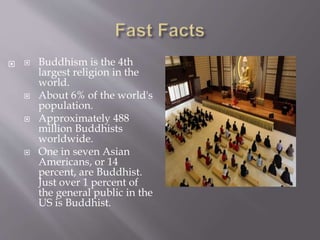Buddhism slides
- 2. ïĻ Buddhism is the 4th largest religion in the world. ïĻ About 6% of the world's population. ïĻ Approximately 488 million Buddhists worldwide. ïĻ One in seven Asian Americans, or 14 percent, are Buddhist. Just over 1 percent of the general public in the US is Buddhist. ïĻ
- 4. 563-483 BC - Siddhartha Gautama or Buddha lives in India. 150 AD - Trade brings Indian people and beliefs to Asia, particularly China. 3rd century - Teachings of Buddha are translated to Chinese. 4th century - Introduced to Korea. 6th century - Introduced to Japan. 1100-1200 - Muslims dominate India and Buddhism becomes a very minor religion in the country. 1800s - Introduced to the United States, mostly on the west coast. Present - Buddhism remains a minor religion in its country of origin, India, with about eight million followers, or 0.8 percent of the total Indian population.
- 8. ïĻ Siddhartha Gautama (Buddha) grew up in a wealthy family. ïĻ Follow a path of self-denial, but did not find truth ïĻ Sat down under a tree, the Bo tree. There he was "enlightened" ïĻ Buddha sat under the Bo Tree for 49 days and was tempted by demons. ïĻ He discovered four noble truths and the Eightfold Path to Nirvana.
- 13. Life, by its unstable nature, has the potentiality of uneasiness, dissatisfaction, frustration and stress. Life hurts. This dissatisfaction is caused by thirsting and craving. There is a path leading to the cessation of dissatisfaction. It is the Noble Eightfold Path which leads out of dissatisfaction, namely:
- 14. 1 Right view or understanding 2 Right Aim or Purpose 3 Right Speech 4 Right Action 5 Right Livelihood 6 Right Effort 7 Right Mindfulness 8 Right Concentration
- 15. ïĻ There are many types of Buddhism in Asia because it has changed from country to country due to culture. ïĻ Followers of Buddhism are vegetarians in 2 days of the lunar month. ïĻ Practicing meditation may lead to Nirvana
- 16. ïĻ What do you think about Buddhism philosophy? (Ways of teaching or educating people) ïĻ Is Buddhism useful in nurturing or educating a person? ïĻ Will you practice Meditation?

















